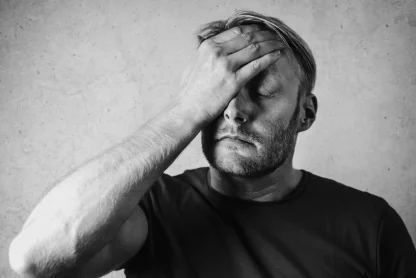Post-Traumatic Stress Disorder (PTSD) is a complex and often debilitating mental health condition that can result from experiencing or witnessing a traumatic event. Individuals living with PTSD may face intense symptoms like flashbacks, nightmares, and severe anxiety that significantly impact their daily lives. However, there is hope. Effective coping strategies can empower individuals with PTSD to manage their symptoms, regain a sense of control, and work towards healing. In this article, we will delve into a range of practical and evidence-based coping techniques that offer solace and empowerment to those navigating the challenging terrain of PTSD. From mindfulness practices to seeking professional support, these strategies provide a roadmap for not only surviving but thriving in the aftermath of trauma
Table of Contents
- Understanding PTSD: A Brief Overview
- The Physical and Emotional Manifestations of PTSD
- Trauma Triggers: Recognizing and Navigating Flashbacks
- Therapeutic Interventions: Talk Therapy and Beyond
- Embracing Mindfulness: Meditation and Grounding Techniques
- The Role of Physical Activity in PTSD Recovery
- Building a Supportive Environment: Friends, Family, and PTSD
- Medications: A Potential Pathway to Relief
- Alternative Therapies: Exploring EMDR, Art, and Music Therapy
- Setting Boundaries: Protecting Your Mental Space
- Facing Fears: Gradual Exposure and PTSD
- The Road Ahead: Resilience and Rebuilding After Trauma
- Frequently Asked Questions

Understanding PTSD: A Brief Overview
Post-Traumatic Stress Disorder, commonly known as PTSD, is a psychological condition that affects millions globally. While trauma is universal, the way it affects our mental health, especially in the form of PTSD, is often misunderstood.
Defining PTSD
PTSD occurs following exposure to traumatic events such as wars, assaults, natural disasters, or personal tragedies. Individuals with PTSD persistently re-experience these traumatic events in the form of nightmares, flashbacks, or intrusive memories. The disorder can also manifest through avoidance behaviors, negative alterations in cognition and mood, and heightened states of arousal.
The Science of Trauma
Traumatic events can lead to profound changes in brain structures responsible for emotion and memory. Research indicates structural changes in regions like the amygdala, hippocampus, and prefrontal cortex in those with PTSD. These alterations are believed to play a role in emotional reactivity and the consolidation of traumatic memories.
Risk Factors for PTSD
While exposure to trauma can potentially affect anyone, not all exposed individuals develop PTSD. Various factors heighten the risk. Prior traumatic experiences, especially in childhood, the severity of the traumatic event, and a family history of mental health disorders can increase susceptibility. Additionally, the absence of a good support system post-trauma can be a significant factor.
Global Prevalence and Importance of Awareness
Estimates suggest that 7-8% of people will develop PTSD at some point in their lives. Such statistics stress the importance of spreading awareness and ensuring accessibility to mental health resources.
Recognizing PTSD’s complexities and widespread impact helps steer the conversation towards acceptance, timely interventions, and the ultimate goal—recovery. As research continues to shed light on this disorder, hope emerges for those grappling with its challenges.
The Physical and Emotional Manifestations of PTSD
Post-Traumatic Stress Disorder (PTSD) is not just a psychological challenge; it’s a holistic disturbance that affects both the mind and body. To truly understand and address PTSD, one must recognize the multifaceted ways it impacts an individual.
Emotional Symptoms of PTSD
This can include:
Flashbacks: Vivid, intrusive memories where the individual feels they are reliving the trauma.
Nightmares: Disturbing dreams related to the traumatic incident.
Emotional Distress: Triggered by anything that reminds the individual of the traumatic event.
Moreover, feelings of detachment from others, persistent negative emotional states, and diminished interest in significant activities are also prevalent.
Physical Symptoms of PTSD
While PTSD is fundamentally a mental health condition, it also manifests physically.
Symptoms can include:
Insomnia: Difficulty in falling or staying asleep.
Jitteriness: Being easily startled or feeling constantly “on edge.”
Chronic Fatigue: A persistent feeling of tiredness.
Muscle Tension: Constant tenseness in the body, leading to pain or discomfort.
Cardiovascular Issues: Increased heart rate and hypertension, especially when recalling the trauma.
These symptoms can often lead to further health complications if not addressed, emphasizing the interconnectedness of mental and physical health.
PTSD is a multi-dimensional disorder with both emotional and physical symptoms. By acknowledging the full range of its manifestations, we can take a comprehensive approach to treatment, addressing both the mind and body’s needs. Through holistic care and understanding, healing becomes an attainable goal for those battling PTSD.
Trauma Triggers: Recognizing and Navigating Flashbacks
Post-Traumatic Stress Disorder (PTSD) often carries the weight of memories, forcing individuals to relive traumatic events through vivid flashbacks. Understanding the triggers that lead to these intense recollections can be a critical step in managing PTSD.
Understanding Trauma Triggers
A trauma trigger is any stimulus that evokes memories or feelings associated with a traumatic event. It could be a sound, sight, smell, or even a date. For example, a car backfiring might trigger someone who has experienced gunfire. These triggers, often innocuous to others, can plunge someone with PTSD into a whirlwind of emotion and distress.
Flashbacks: A Step Back in Time
Flashbacks are one of the most intrusive symptoms of PTSD. During a flashback, an individual may feel or act as though the traumatic event is happening again. This might include experiencing the same emotions they felt during the trauma or even physical sensations. Recognizing the onset of a flashback and the triggers that may have caused it is the first step in managing it.
Navigating Through Flashbacks
Grounding Techniques: These involve reconnecting with the present. This can be done by touching objects, focusing on breathing, or naming items in the room.
Safe Spaces: Identify a place where you can retreat and feel safe during a flashback.
Seek Support: Having someone to talk to, whether it’s a friend or a therapist, can be beneficial. They can help bring you back to the present.
Understanding trauma triggers and flashbacks paves the way for better management of PTSD. By recognizing these elements, individuals can equip themselves with strategies to navigate their symptoms, fostering resilience and recovery.
Therapeutic Interventions: Talk Therapy and Beyond
When confronting the multifaceted challenges of Post-Traumatic Stress Disorder (PTSD), therapeutic interventions provide a beacon of hope. From traditional talk therapy to contemporary methods, there is a spectrum of therapeutic options available, each tailored to the unique needs of the individual.
Talk Therapy: The Bedrock of PTSD Treatment
At the heart of many PTSD treatments is talk therapy, commonly known as psychotherapy. It’s a personal experience where individuals discuss their trauma and its aftermath with a trained therapist, allowing them to process the event, understand their reactions, and develop coping mechanisms. One widely recognized method is Cognitive Behavioral Therapy (CBT), which focuses on altering negative thought patterns related to the traumatic event.
Beyond Talk: Innovative Therapies
While talk therapy has proven immensely beneficial, there’s a growing recognition of alternative therapies that offer relief:
Eye Movement Desensitization and Reprocessing (EMDR): This method involves processing traumatic memories by focusing on external stimuli like guided eye movements.
Prolonged Exposure Therapy: This confrontational method has individuals repeatedly recount their trauma until the memories become less frightening.
The Role of Personalization
There’s no one-size-fits-all in PTSD treatment. Therapists often blend methods or adjust them based on a patient’s feedback, ensuring that the approach resonates with the individual’s experience and comfort level.
Embracing the spectrum of therapeutic interventions available can lead to a more holistic healing journey for those with PTSD. As our understanding of PTSD expands, so too does the toolkit of treatments, offering renewed hope for those seeking to reclaim their lives after trauma.
Embracing Mindfulness: Meditation and Grounding Techniques
Introduction: Finding Solace Amidst Turmoil
In the realm of coping strategies for Post-Traumatic Stress Disorder (PTSD), mindfulness shines as a guiding light. This article delves into the transformative power of meditation and grounding techniques, offering a path to navigate the tumultuous journey of healing.
Meditation: Quieting the Storm Within
Mindful meditation involves focusing on the present moment, inviting a respite from the onslaught of traumatic memories. Research highlights meditation’s ability to reduce PTSD symptoms, enhancing emotional regulation and overall well-being.
Grounding Techniques: Anchoring Amidst Chaos
Grounding techniques serve as lifelines when PTSD’s waves threaten to overwhelm. Engaging the senses by describing your surroundings or holding an object helps anchor you in the present. A study underscores the role of grounding in reducing dissociation and restoring a sense of safety.
The Healing Journey: Practicing Mindfulness
Practicing mindfulness requires patience and consistency. By incorporating mindfulness meditation and grounding techniques into daily routines, individuals with PTSD can gradually reestablish a connection to the present moment, breaking free from the clutches of the past.
Discovering Stillness Amidst Chaos
In the realm of PTSD coping, mindfulness acts as a bridge to inner tranquility. Through meditation and grounding, survivors can rewrite their relationship with their traumatic experiences, embarking on a journey of healing and self-discovery.
The Role of Physical Activity in PTSD Recovery
Amid the quest for coping strategies in the realm of Post-Traumatic Stress Disorder (PTSD), the role of physical activity emerges as a beacon of hope. This article explores how engaging in regular exercise can become a transformative tool in the journey of healing from trauma.
Physical Activity: A Mind-Body Connection
Studies have shown that physical activity isn’t just about boosting physical health; it plays a pivotal role in nurturing emotional well-being. A study underscores the positive effects of exercise on reducing symptoms of anxiety and depression, often intertwined with PTSD.
The Neurobiology of Movement: Changing Trauma’s Impact
Physical activity triggers the release of endorphins, nature’s mood enhancers. It fosters the rewiring of neural pathways, allowing survivors to reclaim a sense of agency over their bodies and minds. A research emphasize the potential of exercise in modulating stress response systems.
Incorporating Physical Activity: A Path to Empowerment
Incorporating physical activity into a PTSD recovery plan need not involve intense workouts; it can be as simple as a brisk walk, yoga, or dancing. By engaging in movement, survivors begin to rewrite their narrative, transitioning from helplessness to empowerment.
Movement as a Catalyst for Transformation
In conclusion, physical activity transcends the realms of muscle and bone; it becomes a conduit for healing the scars of trauma. By embracing movement, survivors take a significant step toward reclaiming their bodies and rekindling their emotional well-being.
Building a Supportive Environment: Friends, Family, and PTSD
Introduction: The Healing Web
In the landscape of coping with Post-Traumatic Stress Disorder (PTSD), a supportive environment is an essential thread in the fabric of recovery. This article explores how the embrace of friends and family can profoundly influence the healing journey for those grappling with trauma’s aftermath.
The Power of Connection: Friends and Family as Pillars
Studies have consistently highlighted the significance of social support in mental health recovery. A study underscores that individuals with strong social networks experience better psychological well-being and increased resilience, attributes crucial for PTSD recovery.
Understanding and Empathy: Key Elements of Support
A supportive environment goes beyond physical presence; it’s about understanding and empathy. Friends and family who educate themselves about PTSD’s intricacies become a beacon of validation and comfort. A study emphasize that empathetic responses from loved ones foster a sense of safety and belonging.
Creating a Healing Space: Nurturing Relationships
Survivors of trauma need safe spaces to express their feelings without judgment. By nurturing an environment where open communication thrives, friends and family become integral to fostering emotional well-being.
Allies in Healing
Friends and family are not just bystanders in the recovery journey; they’re allies in healing. Through their understanding, compassion, and unwavering support, they contribute significantly to the resilience and emotional well-being of those navigating the challenges of PTSD.
Medications: A Potential Pathway to Relief
When grappling with the aftermath of trauma, Post-Traumatic Stress Disorder (PTSD) can cast a shadow over every aspect of life. This article explores the role of medications as a potential pathway to relief in the complex journey of coping with PTSD.
Medications for PTSD: A Multifaceted Approach
Medications can play a crucial role in managing the symptoms of PTSD. Studies, highlight the effectiveness of selective serotonin reuptake inhibitors (SSRIs) and serotonin-norepinephrine reuptake inhibitors (SNRIs) in reducing symptoms of PTSD, offering individuals a chance to regain control over their emotional and mental well-being.
Augmenting Therapy: The Medication-Therapy Combination
Medications can serve as a complement to psychotherapy, enhancing the benefits of counseling or cognitive-behavioral therapy. The synergistic effect of therapy and medication can provide a more comprehensive approach to tackling the complex layers of PTSD.
The Decision Process: Individualized Treatment
The decision to incorporate medications as part of a PTSD coping strategy should be made in consultation with a mental health professional. Factors such as the severity of symptoms, individual response to medications, and potential side effects are important considerations.
Medications as a Supportive Tool
Medications offer a potential pathway to relief for those facing the challenges of PTSD. When integrated into a holistic treatment plan, medications can aid in alleviating symptoms, supporting individuals on their journey towards healing and emotional well-being.
Individuals with PTSD persistently re-experience these traumatic events in the form of nightmares, flashbacks, or intrusive memories. The disorder can also manifest through avoidance behaviors, negative alterations in cognition and mood, and heightened states of arousal.
Alternative Therapies: Exploring EMDR, Art, and Music Therapy
In the realm of Post-Traumatic Stress Disorder (PTSD) coping, alternative therapies emerge as unconventional yet potent tools. This article delves into the transformative power of Eye Movement Desensitization and Reprocessing (EMDR), art therapy, and music therapy in the journey of healing from trauma.
EMDR: Rewiring Trauma’s Impact
Eye Movement Desensitization and Reprocessing (EMDR) is a unique therapy that targets traumatic memories and reprocesses them. Research underscores EMDR’s effectiveness in reducing PTSD symptoms, providing survivors with a newfound sense of control over their traumatic experiences.
Art Therapy: Expressing the Inexpressible
Art therapy provides a creative outlet for expressing complex emotions that words might fail to convey. A study highlights how engaging in art-making can help individuals process trauma, facilitating healing and emotional release.
Music Therapy: Harmonizing Healing
Music therapy harnesses the soothing power of sound to foster emotional well-being. Research suggests that music therapy can alleviate symptoms of anxiety and depression, common companions of PTSD, providing a harmonious channel for healing.
Integrating Alternative Therapies: A Holistic Approach
The integration of EMDR, art therapy, and music therapy can be tailored to individual preferences and needs. These alternative therapies offer diverse avenues to explore and heal from trauma, making them valuable additions to a comprehensive PTSD coping strategy.
A Symphony of Healing
Alternative therapies like EMDR, art therapy, and music therapy expand the horizons of PTSD recovery. By embracing these unconventional tools, survivors can orchestrate a symphony of healing, finding solace and empowerment in their journey towards emotional well-being.
Setting Boundaries: Protecting Your Mental Space
In the journey of coping with Post-Traumatic Stress Disorder (PTSD), setting boundaries becomes an essential armor for safeguarding your mental and emotional well-being. This article delves into the significance of establishing boundaries and how they can contribute to your healing process.
Defining Boundaries: Creating Safe Zones
Boundaries are the lines you draw to protect yourself from situations or people that trigger distress or overwhelm. Research emphasizes that setting healthy boundaries is a form of self-care, an act of reclaiming control over your life and emotions.
The Power of No: Honoring Your Limits
Learning to say “no” is a powerful tool in boundary-setting. It’s an assertion of your needs and limitations. Studies highlight that setting boundaries fosters increased self-esteem and reduced anxiety, both crucial factors in PTSD recovery.
Social Media and Digital Detox: Preserving Mental Sanctity
In the digital age, setting boundaries with technology is equally vital. Taking breaks from social media and technology can prevent exposure to triggering content, providing much-needed respite for your mental space.
Embracing Self-Care: A Boundary You Set for Yourself
Setting aside time for self-care is a paramount boundary you establish. Engaging in activities that nurture your well-being, whether it’s reading, meditating, or spending time in nature, bolsters your emotional resilience.
Empowerment Through Boundaries
Setting boundaries is an act of empowerment for those navigating the tumultuous waters of PTSD. By delineating what’s acceptable and what’s not, survivors pave the way for a healing environment that respects and prioritizes their mental space.
Facing Fears: Gradual Exposure and PTSD
In the journey of coping with Post-Traumatic Stress Disorder (PTSD), confronting fears head-on can lead to profound healing. This article explores the strategy of gradual exposure as a powerful tool to face fears, dismantle triggers, and reclaim control over one’s life.
Understanding Gradual Exposure: A Methodical Approach
Gradual exposure involves confronting distressing memories or situations in a controlled and gradual manner. A study underlines the efficacy of exposure therapy in reducing PTSD symptoms, aiding individuals in rewiring their responses to triggers.
Breaking the Cycle of Avoidance: Reclaiming Power
Avoiding triggers perpetuates the cycle of fear and anxiety. Gradual exposure disrupts this cycle by allowing individuals to experience anxiety in a safe environment, leading to habituation and reduced distress over time.
The Role of a Therapist: Guided Courage
Working with a therapist trained in exposure-based techniques is crucial. Therapists provide guidance, support, and a structured plan to navigate the journey of gradual exposure, making it a transformative experience.
A Journey of Resilience: Overcoming One Step at a Time
Gradual exposure is a journey, not a sprint. By facing fears incrementally, survivors learn that their anxieties are conquerable. This newfound resilience ripples into other aspects of life, fostering emotional growth.
Liberation through Confrontation
Gradual exposure holds the promise of liberation from the clutches of fear and avoidance. By confronting fears with guided courage, individuals with PTSD can rewrite their narrative, emerge stronger, and step into a future defined by resilience.
The Road Ahead: Resilience and Rebuilding After Trauma
Embarking on the journey of coping with Post-Traumatic Stress Disorder (PTSD) marks the beginning of a path toward resilience and rebuilding. This article delves into the profound concepts of resilience and the process of piecing together a life of purpose and growth after trauma.
Resilience as a Beacon: Rising Amidst Adversity
Resilience is the remarkable capacity to bounce back from adversity. Studies underscore that many individuals naturally possess the ability to adapt and recover from traumatic experiences, leading to a renewed sense of purpose.
The Healing Process: Finding Meaning in Pain
Rebuilding after trauma involves weaving a narrative that incorporates the traumatic experience into the broader fabric of one’s life. Research highlights the phenomenon of posttraumatic growth, wherein survivors discover new perspectives, deeper connections, and enhanced inner strength.
Seeking Support: Allies in the Journey
A supportive network can significantly aid in the process of rebuilding. Friends, family, therapists, and support groups create a foundation of understanding and empathy, empowering survivors to navigate their journey toward healing.
Fostering Self-Compassion: A Catalyst for Growth
Practicing self-compassion is pivotal. Recognizing that healing is a non-linear process and allowing oneself to grieve, heal, and grow at their own pace facilitates the process of rebuilding.
Thriving Beyond Trauma
The road ahead after trauma is illuminated by the beacon of resilience. By embracing the concepts of resilience, posttraumatic growth, seeking support, and fostering self-compassion, individuals with PTSD can not only rebuild their lives but also thrive in their newfound strength and purpose.
Frequently Asked Questions
Managing flashbacks and intrusive thoughts associated with PTSD requires targeted strategies. Grounding techniques, where you focus on your surroundings to anchor yourself in the present, can help alleviate distress during flashbacks. Engaging your senses by describing what you see, hear, touch, and smell can be effective. Mindfulness practices, such as meditation and deep breathing, can help regulate anxiety. Working with a therapist trained in trauma-focused therapies can provide strategies to process and reframe traumatic memories, gradually reducing their intrusiveness.
Yes, self-care practices play a significant role in coping with PTSD symptoms. Prioritize self-compassion by recognizing that healing takes time. Engage in activities that bring you joy, relaxation, and a sense of accomplishment. Regular exercise can reduce anxiety and promote the release of mood-enhancing neurotransmitters. Adequate sleep supports emotional well-being and cognitive function. Create a safe and calming environment at home, and establish routines that provide a sense of stability. While self-care practices are valuable, seeking professional help from therapists experienced in trauma treatment is essential for comprehensive support and healing
Managing hypervigilance and heightened arousal, common symptoms of PTSD, requires a multi-faceted approach. Breathing exercises and relaxation techniques can help reduce the physiological responses associated with hypervigilance. Practicing mindfulness can promote awareness of the present moment, allowing you to identify triggers and manage overwhelming sensations. Establishing a routine that includes regular exercise, healthy eating, and sufficient sleep can contribute to overall emotional regulation. Gradual exposure to triggering situations, under the guidance of a therapist, can help desensitize hypervigilance over time.
Absolutely, creative outlets can be incredibly helpful in coping with PTSD. Engaging in creative activities such as art, music, writing, or crafting provides an expressive and therapeutic outlet for emotions. These activities allow you to process and communicate feelings that might be difficult to express verbally. Creative outlets can serve as a form of catharsis, helping you gain insight into your emotions and experiences. Additionally, the act of creation itself can be calming and immersive, promoting relaxation and a sense of accomplishment.









